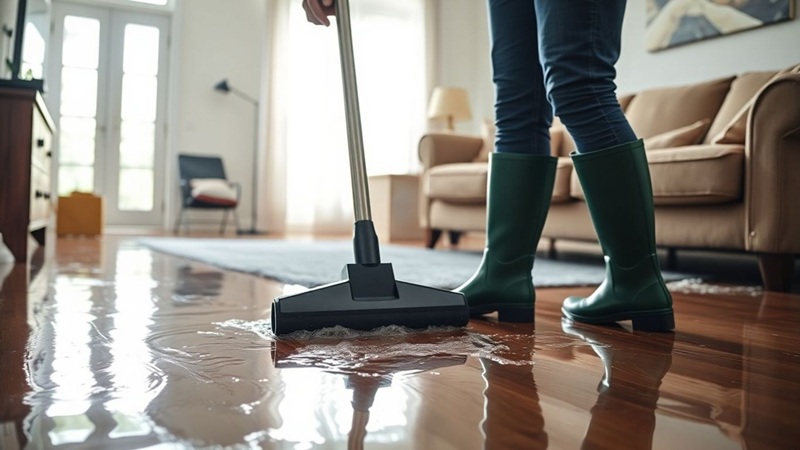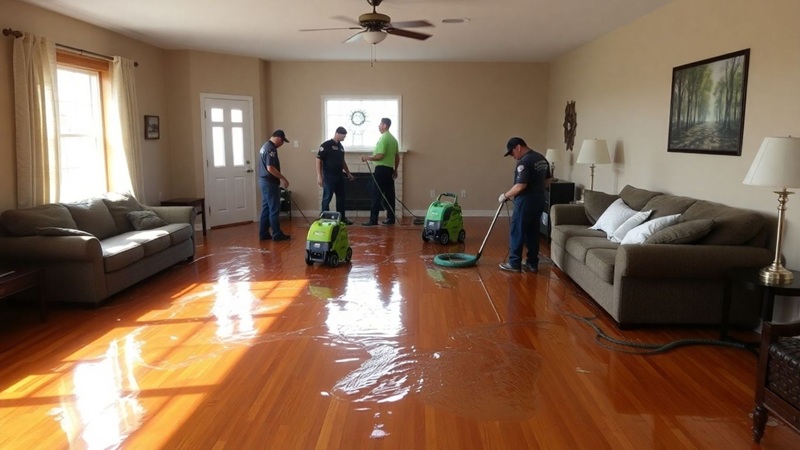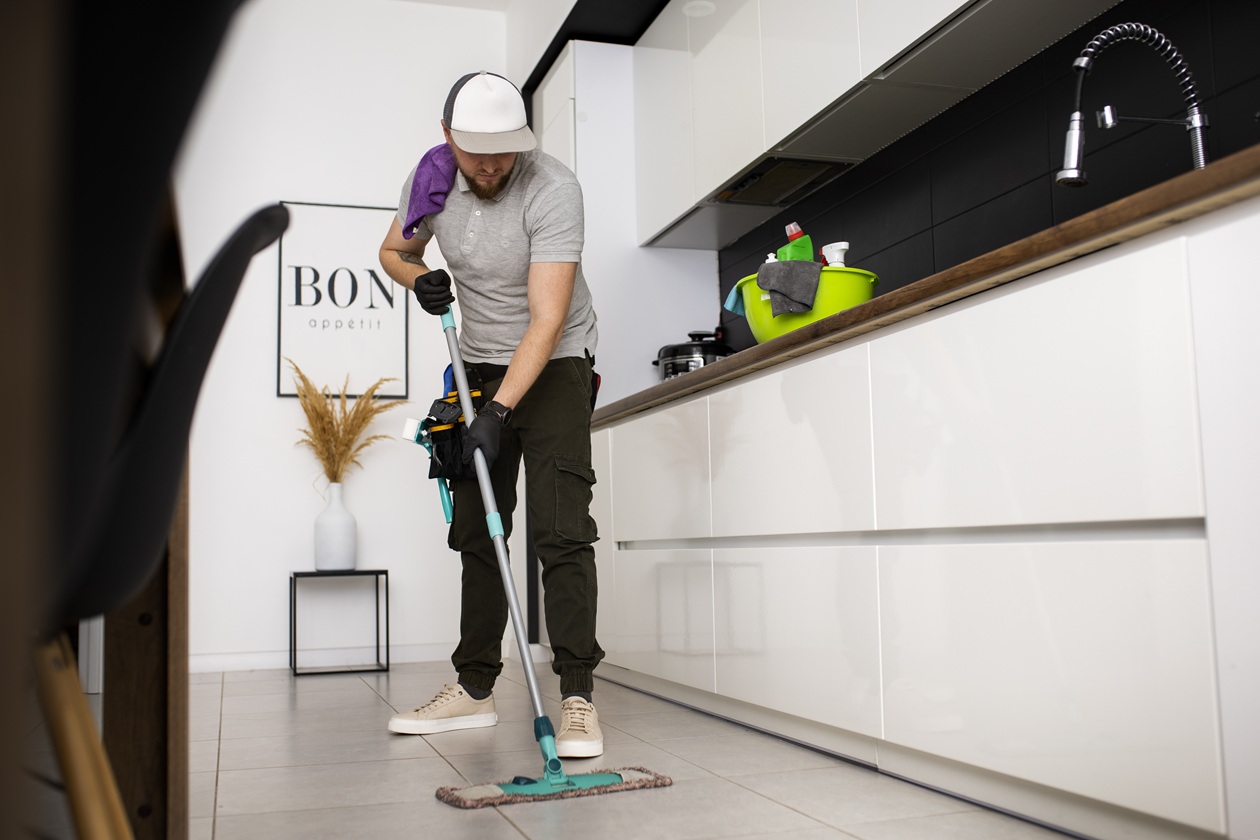Stages of Water Intrusion and Spread
Water doesn’t wait for anyone. As soon as it enters a home, whether through a burst pipe, storm, or appliance failure, it gets right to work soaking everything. In just minutes, floors, carpets, and walls begin to absorb moisture. If fast action isn’t taken, the water damage restoration process becomes even more difficult. The longer things stay wet, the more likely it is that furniture, drywall, and other materials will break down or warp. Mold, smells, and stains start to appear not long after.
Within the first 24-48 hours, mold risk skyrockets, and water makes its way deeper—right into insulation and wood framing. What was a simple puddle now becomes a real problem. After a week, water damage can ruin everything from foundations to wiring.
Even clean water turns nasty if left alone—acting quickly truly matters for every home.
Common Areas Affected by Water Damage
Some places in the house just can’t catch a break when it comes to moisture. Basements and crawl spaces stay high on the list—gravity pulls water there, no matter the source. Bathrooms and kitchens are next in line, thanks to all the pipes and appliances running daily. And let’s not forget attics, especially if roofs leak or ventilation is poor.
- Carpeting and padding
- Drywall and baseboards
- Cabinets, shelving, and hardwood floors
Finding the exact spots hit by water as soon as possible is a key part of effective water damage restoration. If these areas are overlooked, small leaks can turn into big headaches down the road.
Risks of Delayed Response in Restoration
Don’t let time slip away when water damage is in the picture. Waiting too long means not only more broken materials and warped floors but also nasty health hazards like mold spores and dirty air. Electrical problems, rust, and even pests can show up fast if mitigation isn’t started right away.
- Mold settles in after just a day or two.
- Wood beams and framing can weaken in a week.
- The cost of cleanup skyrockets as repairs get bigger and bigger.
A slow response is the enemy of a safe, healthy home. Quick water damage restoration isn’t only about drying things fast—it’s about stopping a chain reaction of destruction before it even starts.
Why Immediate Action Is Critical for Water Damage Restoration
When a home is hit with water damage, every minute on the clock matters. Waiting too long to act can turn a nuisance into a nightmare. Quick response water damage restoration isn’t just a good idea — it’s the only way to stop small problems from becoming huge headaches.
Preventing Structural Complications
Water is relentless. Left sitting, it seeps deep into walls, floors, and foundations. Before you know it, wood starts to warp, drywall turns soft, and even the strongest parts of your house get weaker. Putting off quick response water damage restoration for even a day means repair bills climb higher. Jumping into action early protects your home’s stability and your bank account.
Minimizing the Spread of Mold and Mildew
Mold loves moisture and can start to grow in as little as 24 hours. Once mold takes hold, getting rid of it is tough and costly. Immediate cleanup and drying give mold nowhere to hide or grow. Acting late means you could be breathing in spores and dealing with that musty smell for months. A prompt response keeps things clean and healthy.
Reducing Health Hazards for Occupants
Standing water can become a home for bacteria and other nasty stuff pretty fast. The longer it hangs around, the more likely someone will get sick or allergies will kick in. Quick response water damage restoration isn’t just about property—it’s about everyone’s health under your roof. Going fast keeps everyone safe and gives peace of mind.
The key steps for a fast and effective action:
- Shut off the source of water if possible
- Remove standing water quickly
- Start drying out affected areas super soon
Fast action after a water accident can be the difference between a swift recovery and months of stress. Don’t wait—get to work or call the pros as soon as you notice water where it shouldn’t be.
Step-By-Step Process of Effective Water Damage Restoration
Initial Assessment and Documentation
Before anything else, professionals jump right into a thorough look at the damage. This means checking floors, walls, and hidden areas—no corner gets skipped. They use tools to spot hidden moisture and take lots of photos as proof for your insurance. Nothing beats having solid documentation when it comes time to explain what happened. Fast, detailed assessment is what makes effective water damage restoration possible from the get-go.
Rapid Water Removal and Extraction
Once the inspection is done, the next move is getting rid of standing water. Heavy-duty pumps and vacuums help here, working fast to stop water from soaking in deeper. Technicians move quick because the longer water lingers, the more it seeps into building materials. Quick pulling of water saves both your home and your sanity—there’s no time to waste in effective water damage restoration.
Thorough Drying and Dehumidification
After visible water is out, there’s still moisture hiding in places you can’t see. Dryers and big dehumidifiers kick in, running nonstop until every surface is bone dry. Carpets, cushions, and walls all need special attention. This step is key for stopping mold and making sure damp smells don’t hang around.
Cleaning, Sanitizing, and Restoration
All that water can leave behind grime, odors, and germs. Cleaners move in with disinfectants, scrubbing everything the water touched. This isn’t just about looks; it’s about health, too. The last part of this step is repair—broken drywall, damaged floors, and other fixes get handled. They aim to get your home back to the way it was before the leak.
When a water emergency hits, every minute counts. Skipping even one step in the process of effective water damage restoration can mean months of headaches down the line. Act fast, follow these steps, and get your space back to normal sooner.
Preserving Your Valuables and Home Integrity Through Quick Response

Safeguarding Furniture and Electronics
Quick response can be the difference between salvaging your favorite sofa and losing it to water damage forever. Furniture, especially wood and upholstered pieces, soaks up moisture fast. Electronics can short-circuit or corrode almost immediately if left sitting in water. Pushing to move items to a dry spot and starting quick response water damage steps right away can cut down on costly replacements.
A few steps to help protect these items:
- Unplug and safely remove electronics from affected rooms
- Elevate or relocate furniture to dry areas
- Use fans or dehumidifiers to keep moisture at bay
If you move quickly, you give your prized possessions a fighting chance.
Protecting Important Documents and Keepsakes
Family photos, birth certificates, and old letters can vanish without a trace if exposed to lingering moisture. Quick response to water damage means getting these irreplaceable items out of harm’s way fast. Place them in plastic tubs or waterproof containers at the first sign of trouble.
In some cases, you may be able to air dry documents with fans or gently blot with paper towels. Every minute counts. If moisture sets in for too long, restoring paper items becomes almost impossible. Consider making digital backups whenever possible for peace of mind.
Limiting Damage to Building Materials
When water goes unchecked, floors start to warp, drywall sags, and structural supports grow weak. This kind of trouble snowballs quickly. Quick response water damage steps halt water’s spread before it seeps deep into the heart of your home. The longer materials stay wet, the more likely you’ll need full replacement instead of a simple fix.
| Material | How Fast Damage Sets In | Quick Response Benefit |
| Hardwood Floor | Within hours | Can dry and sand, less warping |
| Drywall | Within 1-2 days | Salvageable with fast drying |
| Carpet | A few hours | Possible cleaning and reuse |
When it comes to water damage in your home, fast action saves more than just money. It preserves memories, comfort, and the very integrity of your living space.
If you’re ever in doubt, always act quickly. Quick response to water damage keeps problems from growing beyond control—and helps keep your home and what matters most safe and dry.
The Hidden Dangers of Neglecting Prompt Water Damage Restoration
When water damage hits, speedy action isn’t just nice to have—it’s a must. Delaying water damage restoration leads to hidden dangers that threaten your health, your wallet, and your home’s structure. Waiting just makes everything harder and much more expensive down the line.
Mold Proliferation and Air Quality Concerns
Mold can start growing in as little as 24 hours after water damage, especially if the area stays damp. Spores spread quickly and affect other rooms, taking over fabrics, walls, and floors. Unchecked mold doesn’t just smell musty—it can seriously harm indoor air quality. People with asthma or allergies are especially at risk.
- Mold starts fast and spreads even faster
- Poor air quality makes homes uncomfortable and even dangerous
- Respiratory issues and allergic reactions are common signs
Compromised Foundations and Structures
Ignoring prompt water damage restoration leaves water to weaken key parts of your home. Wood warps, drywall buckles, and floors swell as the moisture lingers. In worst cases, the very foundation grows unstable, putting the whole building at risk.
- Wooden supports rot
- Metal parts rust
- Floors may sink or become uneven
Don’t let what starts as a minor leak balloon into repairs that eat up your savings. Fixing things early keeps your whole house steady.
Escalating Repair Costs Over Time
The longer water damage sits, the bigger the bill gets. It moves from a simple cleanup to a massive renovation. Here’s a quick look at what happens when you put off quick response water damage restoration:
| Time Elapsed After Damage | Typical Consequence | Estimated Cost* |
| 1–2 days | Easy cleanup, minor fixes | $200–$1,000 |
| 1 week | Mold, wall/ceiling repairs | $2,000–$6,000 |
| 1+ month | Major structure replacement | $8,000–$20,000+ |
*Costs can vary by size and location of the damage.
Letting things sit means water seeps deeper, ruining not just surfaces but the bones of the house. Quick response water damage restoration stops this spiral before it starts.
How Professional Water Damage Restoration Services Make a Difference

When water soaks into your home, acting fast isn’t just about mopping up puddles. Professional water damage restoration services step in where DIY stops. They respond right away, cutting down the stress and uncertainty homeowners face when disaster strikes. Let’s see how these experts truly change the outcome after a water emergency.
Specialized Equipment and Techniques
Ordinary shop vacs and box fans won’t fix major water problems, but pros bring the heavy artillery. They use:
- Industrial pumps to rapidly pull out standing water
- Moisture meters to find hidden damp spots
- Advanced dehumidifiers and air movers to dry floors, walls, and even the air
This gear means the job gets done faster and more thoroughly than any DIY attempt. When it’s about water damage restoration, having the right tools makes all the difference between quick recovery and long-term headaches.
Expertise in Moisture Detection and Mitigation
Seeing a wet spot on your carpet? There’s usually more going on underneath. Professional water damage restoration services rely on experience and specialized tools to:
- Detect moisture behind walls and under floors
- Map out the spread of water so nothing is missed
- Choose the safest, quickest way to get everything truly dry
They know just how quickly mold can grow—so every hidden pocket of moisture is a target for cleanup.
Coordinated Recovery and Repair Efforts
A quick mop-up won’t fix swelling walls or damaged wiring. Professionals coordinate repairs from start to finish:
- Remove water and dry the area fast
- Sanitize to prevent mold and bacteria
- Repair damaged drywall, floors, or insulation as needed
Professional water damage restoration services don’t just clean up—they make your home safe again, handling repairs you might not even notice right away.
If you need to bounce back quickly after a water emergency, professionals are the difference between a lasting solution and lingering damage. When water gets in, make sure you know who to call for real results.
Tips for Preparing Your Household for Emergency Water Damage Events
Emergencies can strike at any moment, and water damage is often one of the most sudden and chaotic situations you’ll face at home. Quick response doesn’t just help with clean-up; it can save your home and wallet from lasting harm. Getting ready ahead of time is one of the best ways to ensure that your family and property stay safe if disaster hits.
Creating an Emergency Response Plan
Every household needs a plan when water hits—standing around in panic isn’t going to do you any favors. Write down clear steps for everyone to take in case of water damage: who grabs the pets, who shuts off the water, who calls for help.
- List out the exact steps for shutting off utilities—water, gas, and electricity.
- Assign simple roles to family members for smoother action.
- Review and practice your plan at least once a year—don’t rely on memory alone.
Even a simple water emergency plan is better than no plan. Quick response always starts with knowing what to do next.
Assembling Essential Supplies and Contacts
No one wants to scramble for a flashlight or phone number when there’s water pouring through the ceiling. Stock your home with:
- A basic emergency kit: flashlight, batteries, gloves, plastic sheeting, duct tape
- Sandbags if you live in a flood-prone area
- A waterproof folder with contact details for insurance, local restoration companies, and nearby family
Here’s a quick table of what to include for a more organized quick response:
| Category | Examples |
| Safety Items | Gloves, boots, masks |
| Contacts | Insurance, plumber, water damage pros |
| Supplies | Buckets, plastic bags, towels, duct tape |
| Documents | Policy info, emergency plans, phone numbers |
Knowing When to Call Restoration Professionals
It might feel tempting to handle it all solo, but there are times when professional help is the only move worth making. Water behind walls, contaminated floodwater, or electrical hazards are not DIY jobs.
- Call a trusted water damage restoration service the moment you feel overwhelmed.
- Don’t wait—mold can form within 24 hours of exposure.
- Having a specialist visit early often means fewer repairs in the long run.
A little preparation and a focus on quick response can go a long way toward keeping your home, belongings, and loved ones secure when water damage comes knocking. Sometimes, being ready is all it takes to turn a big problem into a manageable one.
Conclusion
Water damage can turn a normal day upside down, but acting fast really does make all the difference. The longer water sits, the more problems it causes—ruined floors, mold, and even damage you can’t see right away. Quick action helps keep repair costs down, saves your belongings, and protects your health. It’s not just about drying things out; it’s about stopping the damage before it spreads. Calling in professionals as soon as possible means you get the right tools and know-how on your side. In the end, a fast response is the best way to protect your home and get things back to normal with less stress and expense.










Leave a Reply